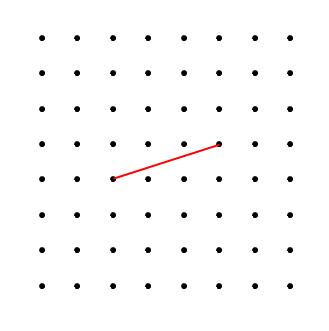Or search by topic
Number and algebra
Geometry and measure
Probability and statistics
Working mathematically
Advanced mathematics
For younger learners
Opposite Vertices



- Problem
- Getting Started
- Student Solutions
- Teachers' Resources
Why do this problem?
Possible approach
These printable worksheets may be useful: Opposite Vertices - Squares
Opposite Vertices - Rhombuses
10mm Dotty Grid
You may be interested in our collection Dotty Grids - an Opportunity for Exploration, which offers a variety of starting points that can lead to geometric insights.

- the side of at least one square,
- the diagonal of at least one square,
- the side of at least one rhombus,
- the diagonal of at least one rhombus.
Alternatively, start by showing the image of Charlie's rubbed out squares, and give students some time to recreate the squares on dotty paper. Once they have finished, ask them to compare in pairs - have they always drawn the same
square? Are there any other possibilities?
Bring the class together and share the techniques students were using to complete the squares.
"Draw any line you like on your dotty paper, and then try to complete a square using your line as one of the sides."
...
"Has anyone found a line that they can't use as a side of a square?" (If someone has found one, display it on the board and ask the class to help.)
"Do you think we can always draw a square using any line?"
Give students some time to discuss this and come up with justifications for their answer.
Next show the image of Alison's diagonals and give students time to recreate the squares.
Again, ask them to share approaches.
"Draw any line you like on your dotty paper, and then try to complete a square using your line as the diagonal."
This time, it can't always be done. If students are struggling to work out when it can and can't be done, suggest that they draw some squares and see what the diagonals have in common.
Then move on to rhombuses.
"Draw any line you like on your dotty paper, and then try to complete a rhombus using your line as one of the sides. How many different rhombuses can you draw using your line?"
Give students time to do this for a number of different lines of their own choosing, and then bring the class together to share their findings.
"When we worked on squares, there were some lines that we couldn't use as a diagonal. Will the same be true for rhombuses?"
Once again, give students time to explore.
Finally, bring the class together to share their ideas and justify their findings.
One technique for testing ideas at the end is to set a specific challenge, for example, to draw some lines and ask them to determine how many rhombuses could be drawn using each line as a diagonal.
Key questions
Possible support
The interactivity in Square Coordinates helps students to visualise tilted squares.
Possible extension
Vector Journeys challenges students to explore similar relationships using vector algebra.
You may also like
Square Areas
Can you work out the area of the inner square and give an explanation of how you did it?
2001 Spatial Oddity
With one cut a piece of card 16 cm by 9 cm can be made into two pieces which can be rearranged to form a square 12 cm by 12 cm. Explain how this can be done.

